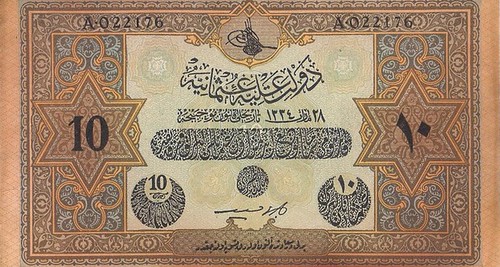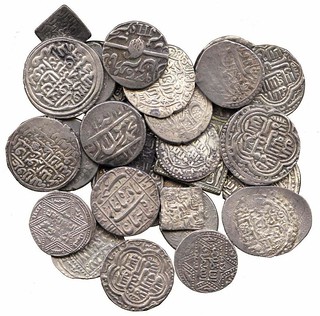
PREV ARTICLE
NEXT ARTICLE
FULL ISSUE
PREV FULL ISSUE
A MONETARY HISTORY OF ISLAMIC SOCIETIES
This article from the Daily Sabah published May 20, 2016 is a short summary of money in the Islamic world. Here's an excerpt.
-Editor

The use of money dates back thousands of years. As in other cultures, minting of coins and banknotes was a reflection of a ruler's power in Islamic societies, although their shapes and names have changed over and over again Before the arrival of Islam, Arab, Persian and Roman gold and silver coins were used in Mecca and Prophet Muhammad used these coins as well. Caliph Umar was the first ruler that issued coins in Islamic history. In 640 A.D., 18 years after the Hegira, Umar issued short, thick coins in the shape of kernels, weighing 3.36 grams and reminiscent of Persian coins. Caliph Uthman issued gold and silver coins in 650 B.C. The first round silver coin was issued by Caliph Abd Allah ibn al-Zubayr (680-692) in Mecca. Most of the Islamic states issued coins. Gold and silver coins issued with a certain weight are called "sikke." 
Islamic silver coins from the Abbasid and Ayyubid caliphates Although Seljuk coins were used in the early Ottoman period, Sultan Osman I, the founder of the Ottoman Empire, issued the first Ottoman silver coin called "akche." These akches weighed 0.68 grams at first, but they later varied in weight. In the 17th century the amount of silver used in akches was reduced one-sixth. The very first Ottoman golden coin was issued by Mehmed the Conqueror in 1478. Later on, various coins were issued and several laws were introduced to standardize coin minting. During the reign of Sultan Murad I, copper coins called "mangýr" or "fülüs" were issued to facilitate purchasing less valuable products. The amount difference between the coins' expense and their written value were recorded in the treasury. The practice of printing the date on coins started with Sultan Bayezid I and printing the sultan's signature, or "tughra," on coins became regular practice Sultan Mehmed I. Apart from Ottoman coins, Venetian, Polish, Dutch, German, French, Egyptian and Persian coins also circulated in the Ottoman Empire. Since the arrival of money, gold and silver have been considered currency in every community whether the coins bore the portrait of Napoleon Bonaparte or an Ottoman sultan. Akche, the silver coin, was the official currency of the Ottoman Empire. The gold coin was considered big money while mangýr was on the other end of the spectrum. After 1687, "kurush" were announced as the official Ottoman currency. Three mangýrs (aka "pul") were equal to one akçe, three akches were equal to one "para," 40 paras were equal to one silver kurush and 100 kurush were equal to 1 Ottoman gold coin. Whenever a new sultan succeeded to the throne, he prohibited the use of the coins issued by his predecessor and introduced new ones. The public took the old coins to the state mint and they were melted and minted into new coins for a small fee. As the treasury was drained with wars, the amount of silver in akche was reduced, but this caused dissatisfaction among the public. During the reign of Sultan Abdülmecid, the akche was withdrawn from circulation and instead silver coins called "majidiya," which weighed 24 grams, were issued. An Ottoman gold coin of 7.2 grams was equal to five majidiyas, one majidiya was equal to 20 silver kurush and 1 kurush was equal to 40 paras. To read the complete article, see:

Wayne Homren, Editor The Numismatic Bibliomania Society is a non-profit organization promoting numismatic literature. See our web site at coinbooks.org. To submit items for publication in The E-Sylum, write to the Editor at this address: whomren@gmail.com To subscribe go to: https://my.binhost.com/lists/listinfo/esylum All Rights Reserved. NBS Home Page Contact the NBS webmaster 
|